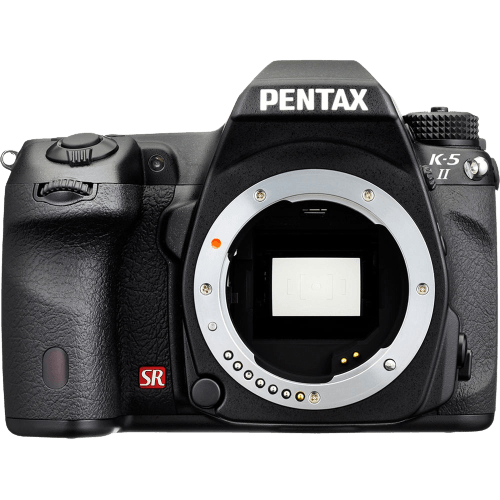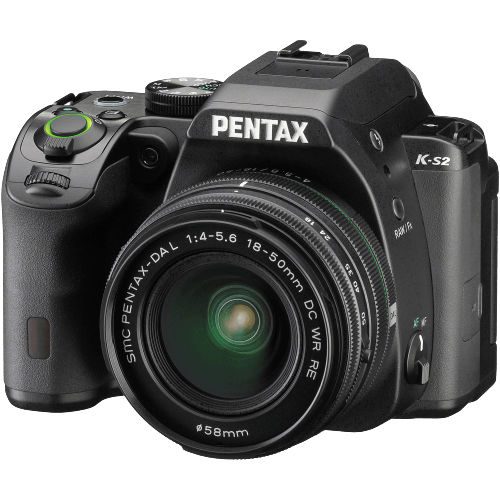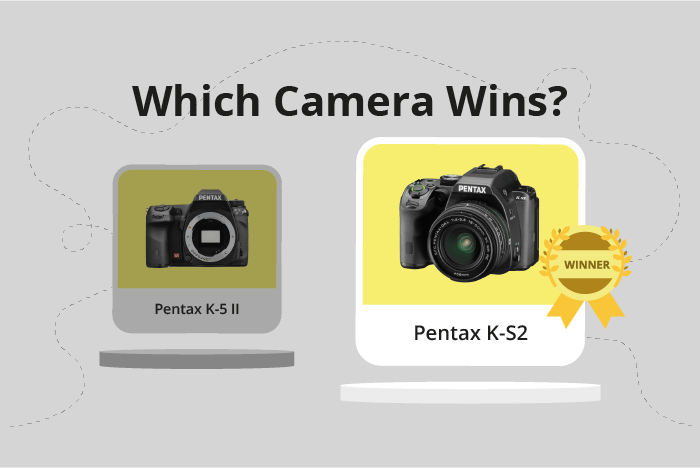Pentax K-5 II vs K-S2 Comparison
Pentax K-5 II

Pentax K-S2

The Pentax K-S2 outperforms the Pentax K-5 II with a score of 66/100 compared to 57/100. Both cameras share the DSLR category and were released in 2012 and 2015, respectively. The K-S2 has a significant advantage with its lower launch price of $800, compared to the K-5 II’s $999. Additionally, the K-S2 is lighter, weighing 678g (1.49lbs) against the 760g (1.68lbs) of the K-5 II, making it more convenient for travel and extended use.
However, the K-5 II does have a slightly larger camera size, measuring 131 x 97 x 73mm compared to the K-S2’s 91 x 123 x 73mm. This may provide a more comfortable grip for some users. Despite this, the Pentax K-S2 remains the superior option due to its higher score, lower price, and lighter weight.
Pentax K-5 II vs K-S2 Overview and Optics
The Pentax K-S2 outperforms the Pentax K-5 II in optics, scoring 70 out of 100 points, compared to the K-5 II’s score of 60 points. Both cameras share some common specifications, such as the CMOS sensor type, APS-C sensor size, Pentax KAF lens mount, and image stabilization.
The K-S2 has a higher megapixel count of 20, compared to the K-5 II’s 16.3 megapixels. This results in better image quality and higher resolution photos. Additionally, the K-S2 features a more advanced processor, the Prime MII, which contributes to faster image processing and improved overall performance. The K-S2 also boasts a higher DXOMARK score for the sensor, with a score of 88, compared to the K-5 II’s score of 82, indicating superior image quality and low-light performance.
On the other hand, the K-5 II has a faster shooting speed of 7 frames per second, compared to the K-S2’s 5.4 frames per second. This makes the K-5 II more suitable for capturing fast-moving subjects and action photography.
Taking these factors into account, the Pentax K-S2 offers better image quality, resolution, and processing performance than the Pentax K-5 II, making it the superior choice for those prioritizing these factors. However, the K-5 II’s faster shooting speed may appeal to those who frequently capture fast-paced action. Ultimately, the choice between these two cameras depends on the photographer’s specific needs and preferences.
Pentax K-5 II vs K-S2 Video Performance
The Pentax K-S2 outperforms the Pentax K-5 II in video capabilities, earning a score of 70/100 compared to the K-5 II’s 57/100. Both cameras share some common specifications, such as Full HD (1920 x 1080) maximum video resolution and built-in time-lapse functionality. However, the K-S2 has distinct advantages that make it the superior choice for video recording.
The K-S2’s most significant advantage is its maximum video frame rate of 60fps, which is more than double the K-5 II’s 25fps. This higher frame rate allows for smoother video playback and enables users to capture fast-moving subjects with greater clarity. Additionally, the increased frame rate provides more flexibility in post-production, such as the option to create slow-motion footage without sacrificing video quality.
While the K-5 II does not offer any notable advantages over the K-S2 in terms of video capabilities, it still manages to provide satisfactory performance for casual video recording. With Full HD resolution and built-in time-lapse functionality, the K-5 II can be a suitable option for users who do not prioritize video performance in their camera selection.
Taking into account the significant difference in video scores and the K-S2’s superior frame rate, it is evident that the Pentax K-S2 is the better choice for those seeking a camera with enhanced video capabilities. The K-5 II, while not as strong in this aspect, remains a viable option for users who do not require advanced video features.
Pentax K-5 II vs K-S2 Features and Benefits
The Pentax K-S2 outperforms the Pentax K-5 II in features, with a score of 68/100 compared to the K-5 II’s 54/100. Both cameras share the same screen size and resolution, at 3 inches and 921,000 dots, respectively. Neither camera has a touchscreen.
The main strengths of the K-S2 lie in its additional features. It has a flip screen, GPS, WIFI, and Bluetooth capabilities, all of which are absent in the K-5 II. These features make the K-S2 a more versatile and connected camera, allowing for easier framing of shots, location-based data, and seamless sharing of images.
The K-5 II, while lower in its feature score, may have some advantages in other areas. However, based on the given information, it is not possible to determine any specific strengths it may have over the K-S2, as their shared specifications are the same.
Considering the feature scores and specifications, the Pentax K-S2 emerges as the superior camera in terms of features. Its flip screen, GPS, WIFI, and Bluetooth capabilities make it a more attractive option for photographers who value versatility, connectivity, and convenience. The Pentax K-5 II, on the other hand, does not offer any clear advantages over the K-S2 in this regard. Based on the information provided, the K-S2 is the better choice for users seeking a feature-rich camera.
Pentax K-5 II vs K-S2 Storage and Battery
The Pentax K-5 II outperforms the Pentax K-S2 in storage and battery with a score of 43/100, compared to the K-S2’s 24/100. Both cameras have one memory card slot and accept SD, SDHC, and SDXC cards. However, the K-S2 also supports UHS-I compatible cards.
The K-5 II has a significant advantage in battery life, offering 980 shots per charge with its D-LI90P battery. The K-S2, using a D-LI109 battery, provides only 410 shots per charge. Neither camera has USB charging capabilities.
While the K-S2’s UHS-I compatibility may offer faster data transfer rates, it does not make up for its limited battery life. The K-5 II’s longer battery life makes it a more reliable option for extended shooting sessions. Despite the K-S2’s lower score, it remains a viable option for casual photography or situations where battery life is not a primary concern.
Pentax K-5 II vs K-S2 – Our Verdict
Are you still undecided about which camera is right for you? Have a look at these popular comparisons that feature the Pentax K-5 II or the Pentax K-S2:

